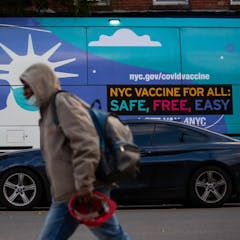
Articles on Health inequity
Displaying 21 - 40 of 61 articles

Biased algorithms in health care can lead to inaccurate diagnoses and delayed treatment. Deciding which variables to include to achieve fair health outcomes depends on how you approach fairness.

Though many Americans believe that parasitic infections exist in poorer countries, research shows that the problem exists in the US and has a higher impact in communities of color.

As negotiations for an international pandemic treaty get underway, public engagement is in the best interests of Canadians. Here is how the federal government is consulting affected populations.

The Albanese government has promised a centre for disease control. Its main focus has to be health equity for disadvantaged groups.

The US PEPFAR initiative has brought HIV medication to millions of people globally. Behind this progress are the activists that pressured politicians and companies to put patients over patents.

Prejudice and stigma can discourage the communities most affected by infectious diseases from seeking care. Inclusive public health messaging can prevent misinformation and guide the most vulnerable.

Systemic social issues affect vaccine access and acceptability. Yet, the term ‘vaccine hesitancy’ overlooks this, reducing the multiple factors that affect vaccine uptake to individual-level choices.

Time is running out to expand an agreement to relax patent rules on COVID vaccines. Members of the World Trade Organization should broaden its scope to treatments and tests.

If we want people with complex care needs to prioritise their health, cutting patient fees, providing flexible hours and paying attention to their social circumstances would be a good start.

Children and youth in care are more likely to have experienced trauma that can affect future health. A comprehensive, trauma-informed health strategy for these children and youth is long overdue.

Appalachia has one of the highest rates of oral health problems per person in the US.

Overcoming the access barriers and biases that underrepresented and underserved communities face could not only improve research participation but also improve care.

The omission of growing evidence that Māori, and Māori women in particular, have worse health outcomes after HIV infection could derail New Zealand’s elimination plans and exacerbate disparities.

During spring and summer, as more people consider exercising outdoors, a trauma- and violence-informed approach to physical activity can help ensure equity, inclusion, safety and access.

For people who struggle to meet their basic needs, it will take a lot more than simple psychological exercises to flourish. It will take systemic change.

People living in poverty or disadvantage are three times more likely to die from COVID than the wealthy.

On the surface, sober months like Dry January and Dry February are great. But we need to broaden the discussion around how privilege and policy impact one’s relationship with alcohol and other drugs.

Governance structures that provide opportunities for people to contribute to decision-making would also enhance people’s abilities to control important factors in their life.

Addressing racial and ethnic health gaps is becoming even more important as the US population continues its shift toward a minority-majority nation.

Vaccines and medical treatments can only go so far in an unequal society. Facing the ongoing history of racial discrimination and bias in the US would help end the pandemic.

